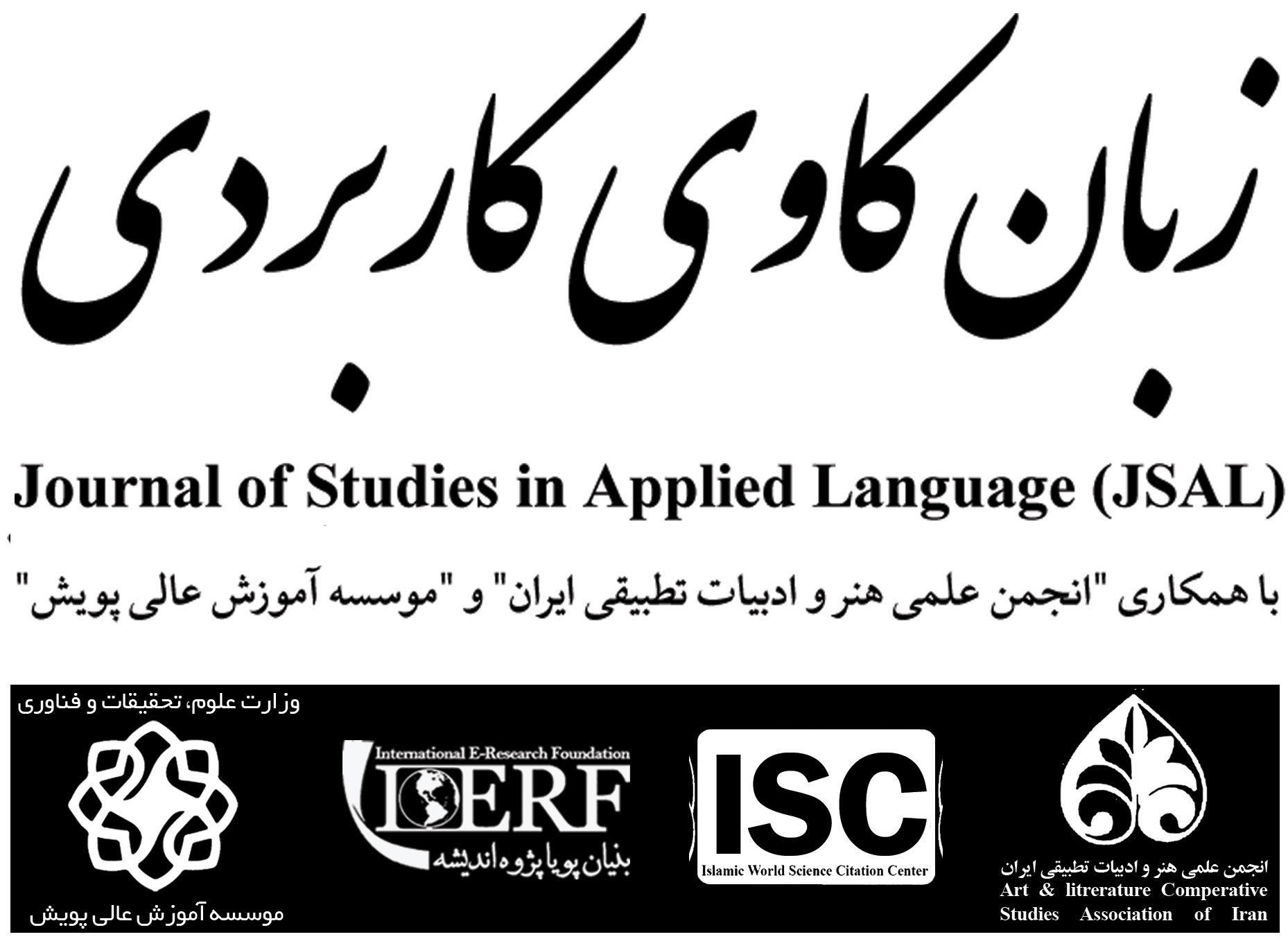<>
Volume 8, Issue 2 (5-2025)
JSAL 2025, 8(2): 67-89 |
Back to browse issues page
Download citation:
BibTeX | RIS | EndNote | Medlars | ProCite | Reference Manager | RefWorks
Send citation to:



BibTeX | RIS | EndNote | Medlars | ProCite | Reference Manager | RefWorks
Send citation to:
Shokati Moqarab S, Nabavi-Zadeh Namaazi S V. (2025). Conceptualization of “Death” in the Speeches of Qassem Soleimani:A Cognitive Approach to the “Good–Evil” Dichotomy [In Persian]. JSAL. 8(2), 67-89.
URL: http://jsal.ierf.ir/article-1-181-en.html
URL: http://jsal.ierf.ir/article-1-181-en.html
1- Assistant Professor, Department of Foreign Languages and Linguistics, Faculty of Literature and Humanities, Shiraz University, Shiraz, Iran
2- PhD in North American Studies, Faculty of World Studies, University of Tehran, Tehran, Iran ,s.v.namazi@ut.ac.ir
2- PhD in North American Studies, Faculty of World Studies, University of Tehran, Tehran, Iran ,
Abstract: (659 Views)
Metaphor is an important element of ideology and identity; it provides a cognitive and conceptual framework for shaping worldviews, allowing specific perspectives to be emphasized while competing ones are marginalized or rejected. This paper addresses the question: Through what cognitive models does Qassem Soleimani represent the good–evil (truth–falsehood) dichotomy in his speeches? To answer, the study examines three key texts (his will, his letter to the Leader announcing the end of ISIS, and a speech to shrine defenders) using conceptual metaphor theory as proposed by Lakoff and Johnson (2008) and Kövecses (2020). The discursive reproduction of this concept is studied within in-group and out-group relations. Good and evil are represented through conceptual emphasis on path, journey, and travelers with different goals and destinations. Data analysis applies the metaphor “Life is a Journey” to explain its elements: travelers, routes, destinations, shared goals, and obstacles. References to Zionism, arrogance, and the general “falsehood front” portray destructive destinations, while the “path of truth” depicts travelers such as fighters and martyrs, where the destination is martyrdom and spiritual elevation. Findings indicate that Soleimani’s speeches construct this cognitive dichotomy through the “Life is a Journey” metaphor, focusing mainly on the in-group rather than the out-group, depicting the path of good or truth with concepts such as jihad, martyrdom, and the way of the righteous servant. Although there are limited references to the out-group as “falsehood”, it is ultimately the choice of path that determines whether entities belong to the in-group or out-group in competing discourses. This demonstrates how cognitive interpretive systems shape identity boundaries and discursive structures.
Type of Study: Research |
Subject:
Discourse Analysis
Received: 2025/01/26 | Accepted: 2025/05/31 | Published: 2025/05/31
Received: 2025/01/26 | Accepted: 2025/05/31 | Published: 2025/05/31
References
1. Afkhami A, Shakiba K. (2017) "Ideological representation of Iran & England's newspapers: A Critical Metaphor Analysis". LRR, 8 (7), pp. 209-231. DOR: 6.16.7.8.1396.23223081.1.1001.20 [In Persian]
2. Ansarian, S. and Davari Ardakani, N. (2023). "Conceptual Metaphor and Blending in Critical Discourse Analysis of Iran's Political Cartoons". Journal of Sociolinguistics, 6(1), pp. 25-38. DOI: 10.30473/il.2022.58571.1458 [In Persian]
3. Cameron, L. (2003). Metaphor in Educational Discourse. London: Continuum. [In English]
4. Chilton, P. A. (1996). Security metaphors: Cold war discourse from containment to common house. New York: Peter Lang. [In English]
5. Chilton, P., & Ilyin, M. (1993). "Metaphor in political discourse: The case of thecommon European house". Discourse & society, 4(1), pp.7-31. DOI: 10.1177/0957926593004001002 [In English] [DOI:10.1177/0957926593004001002]
6. Coulson, A. J. (1994). "Human life, human organizations and education". Education Policy Analysis Archives, 2, pp. 9. DOI: 10.14507/epaa.v2n9.1994 [In English] [DOI:10.14507/epaa.v2n9.1994]
7. Croft, W. (2009). "Toward a social cognitive linguistics". New directions in cognitive linguistics, 24, pp. 395-420, DOI: 10.1075/hcp.24.25cro?locatt=mode:legacy [In English] [DOI:10.1075/hcp.24.25cro]
8. Deignan, A. (2005). "A corpus linguistic perspective on the relationship between metonymy and metaphor". Style, 39(1), pp. 72-91. [In English]
9. Eubanks, P. (2000). A war of words in the discourse of trade: The rhetorical constitution of metaphor. SIU Press. [In English]
10. Evans, V., & Green, M. (2018). Cognitive linguistics: An introduction. Routledge. [In English] [DOI:10.4324/9781315864327]
11. Fairclough, N. (1996). Language and Power. 10th edition. Essex: Longman Group UK Limited. [In English]
12. Fauconnier, G. (2006). Pragmatics and cognitive linguistics. The handbook of pragmatics, Blackwell Publishing, DOI: 10.1002/9780470756959.ch29 [In English] [DOI:10.1002/9780470756959.ch29]
13. Fauconnier, G., & Turner, M. (2003). "Conceptual blending, form and meaning". Recherches en communication, 19, pp. 57-86. DOI: 10.14428/rec.v19i19.48413 [In English] [DOI:10.14428/rec.v19i19.48413]
14. Hart, C. (2010). Critical Discourse Analysis and Cognitive Science: New Perspectives on Immigration Discourse. New York: Palgrave Macmillan. [In English] [DOI:10.1057/9780230299009_2]
15. Koller, V. (2004). Metaphor and gender in business media discourse: A critical cognitive study. Basingstoke: Palgrave. [In English] [DOI:10.1057/9780230511286]
16. Kövecses, Z. (2005). Metaphor in Culture. Cambridge: Cambridge University Press. [In English] [DOI:10.1017/CBO9780511614408]
17. Kövecses, Z. (2009). Metaphor, culture, and discourse: The pressure of coherence. In Metaphor and discourse (pp. 11-24). London: Palgrave Macmillan. [In English] [DOI:10.1057/9780230594647_2]
18. Kovecses, Z. (2010). Metaphor: A practical introduction. Oxford University Press. [In English]
19. Kövecses, Z. (2020). Extended Conceptual Metaphor Theory. Cambridge: Cambridge University Press. [In English] [DOI:10.1017/9781108859127]
20. Lakoff, G. & Johnson, M. (2008 [1980]). Metaphors we live by. University of Chicago press. [In English]
21. Lakoff, G. (1993). The contemporary theory of metaphor. In Metaphor and Thought (pp. 202-252). Cambridge: Cambridge University Press. [In English] [DOI:10.1017/CBO9781139173865.013]
22. Langacker, R. W. (1995). Cognitive grammar. In Concise History of the Language Sciences (pp. 364-368). Pergamon. [In English] [DOI:10.1016/B978-0-08-042580-1.50060-X]
23. Mandelblit, N., & Zachar, O. (1998). "The notion of dynamic unit: Conceptual developments in cognitive science". Cognitive Science, 22(2), pp. 229-268. [In English] [DOI:10.1207/s15516709cog2202_3]
24. McNeill, D. (Ed.). (2000). Language and gesture (Vol. 2). Cambridge University Press. [In English] [DOI:10.1017/CBO9780511620850]
25. Moloodi, A. and NabaviZadeh Namazi, S. V. (2021). "Application of the Conceptual Theory of Metaphor and Metonymy to Iran's Cinema: A Case Study of "the Snow on the Pines". Journal of Researches in Linguistics, 13(1), 181-216. DOI: 10.22108/jrl.2022.128375.1573 [In Persian]
26. Musolff, A. (2000). Mirror images of Europe: Metaphors in the public debate about Europe in Britain and Germany. Munich: Iudicium. [In English]
27. Musolff, A. (2004). Metaphor and political discourse: Analogical reasoning in debates about Europe. Basingstoke: Palgrave Macmillan. [In English]
28. Musolff, A. (2006). "Metaphor scenarios in public discourse". Metaphor and Symbol, 21(1): pp. 23-38. DOI: 10.1207/s15327868ms2101_2 [In English] [DOI:10.1207/s15327868ms2101_2]
29. Musolff, A. (2016). Political Metaphor Analysis; Discourse and Scenarios, New York: Bloomsbury Academic. [In English]
30. Nabavi-Zadeh Namazi, S. V., Ghahramani, M. B., Ghasemitari, Z., Zarif Khonsari, M. J. and Moloodi, A. (2024). "Conceptualization of the Hegemon Discourse of the Post-Revolutionary Iran in Septembers of Shiraz: A Cognitive-Multimodal Discourse Analysis". Journal of World Sociopolitical Studies, 8(4), pp. 653-805. DOI: 10.22059/wsps.2025.384953.1469 [In English]
31. Rezaeipanah, Amir and Somayeh Shawkat Moqrab (2018). "Analysis of the Circuits of Identity and Otherness in Barack Obama and Donald Trump's Statements on the JCPOA". 10th International Conference on Iranian Linguistics. Tehran: Allameh Tabatabaei University. [In Persian]
32. Ritchie, D. (2004). "Metaphors in conversational context: Toward a connectivity theory of metaphor interpretation". Metaphor and symbol, 19(4), pp. 265-287. DOI: 10.1207/s15327868ms1904_2 [In English] [DOI:10.1207/s15327868ms1904_2]
33. Shokati Moqarab, S. and Rahimian, J. (2022). "Investigating the manner of drawing the identity-based foundations in Joe Biden's presidential inaugural speech through conceptual metaphors". Journal of Linguistics and Khorasan Dialects, 14(1), pp. 209-232. DOI: 10.22067/jlkd.2022.76029.1094 [In Persian]
34. Talmy, L. (2000). Toward a cognitive semantics (Vol. 2). Cambridge: MIT Press. [In English] [DOI:10.7551/mitpress/6847.001.0001]
35. Van Hoek, K. (1997). Anaphora and conceptual structure. University of Chicago Press. [In English]
Send email to the article author
| Rights and permissions | |
 |
This work is licensed under a Creative Commons Attribution-NonCommercial 4.0 International License. |







